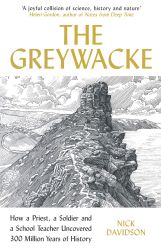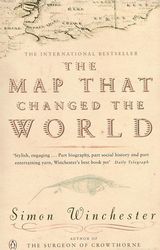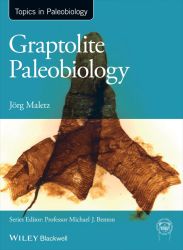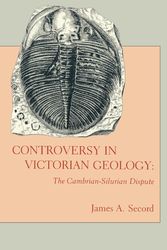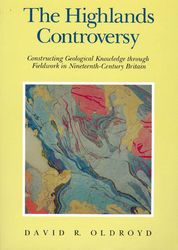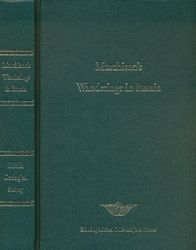keywords: geology, history of science
Take a look at the geological time scale[1]. Thanks to the dinosaurs, we have all heard of the Cretaceous, Jurassic, and Triassic. However, going back in time from the Triassic, the Phanerozoic Eon in which we live today stretches another 289 million years into the past; from the Permian that ended ~252 million years ago, through the Carboniferous, Devonian, Silurian, Ordovician, to the Cambrian that started ~539 million years ago. In The Greywacke, avocational geologist Nick Davidson tells the story of how those geological periods got their names and transports the reader back to the heydays of Victorian geology when three men would make Britain’s rocks the centre of international attention. In so doing, he unlocks for a general audience an episode in the history of geology that was so far consigned to more technical literature.

The Greywacke: How a Priest, a Soldier and a Schoolteacher Uncovered 300 Million Years of History, written by Nick Davidson, published by Profile Books in May 2021 (hardback, 280 pages)
When William Smith produced the first stratigraphical map of England and Wales in 1815, he was not able to further classify the rocks of Wales. A chaotic and incomprehensible jumble of hard-to-trace strata, they were collectively referred to as the titular Greywacke. Given that these rocks might contain the first evidence of life on Earth, they were of great interest to geologists. From 1831 to 1920, three scholars would spend their lifetimes deciphering them.
Davidson dedicates most of his book to the careers and achievements of Adam Sedgwick (1785–1873) and Roderick Murchison (1792–1871). Sedgwick split his time between his clerical duties as a priest and his academic duties as a geology professor in Cambridge. Murchison was a retired soldier with unfulfilled dreams of military glory and a family fortune to burn on his new geology hobby. Both were members of the Geological Society of London and, starting in 1832, decided to collaborate on cracking the identity of the Welsh rocks.
A very brief outline, which Davidson develops in detail over the course of nine chapters, runs something like this. Dividing Wales between them, both men identified a series of rock strata. Sedgwick called his seemingly older series the Cambrian and Murchison called his seemingly younger series the Silurian. The problem that they decided to largely ignore, and that would come back to haunt them, was whether these sequences overlapped in time or were separate. Sedgwick’s career subsequently stalled; doubts, procrastination, poor health, and the workload of clerical and administrative duties all took their toll. Despite encouragement from Murchison and other geologists, he was unable to develop a more sophisticated understanding of the Cambrian rocks, nor identify diagnostic fossils. Murchison, however, became a celebrity, his Silurian system widely adopted. In Devon, together with Sedgwick, he resolved confusion over the presence of younger Carboniferous strata amidst older Silurian rocks by designating the intermediate layer with anomalous fossils as Devonian. In western Russia, he identified the Permian, a new rock layer named after the Russian city of Perm. His book on the geology of Russia won him international accolades and he was basking in the fame and glory he never achieved as a soldier.
“the rocks of Wales, a chaotic and incomprehensible jumble of hard-to-trace strata, were collectively referred to as the Greywacke. […] From 1831 to 1920, three scholars would spend their lifetimes deciphering them.”
As Davidson details, though, Murchison’s fame had some shady sides to it. He rarely acknowledged the geologists and quarrymen who helped him in the field. He glossed over stratigraphical inconsistencies and fossil anomalies. And as he climbed the social ladder, his contemporaries noted in private his increasing arrogance and condescending nature. Younger geologists were quietly suspicious that his sweeping picture was hiding a more nuanced and complex story, but few would openly confront him. Two episodes, told here, illustrate why. By 1852, the souring friendship between Sedgwick and Murchison blew up over the above-mentioned overlap between Cambrian and Silurian strata in Wales that both men were laying claim to. Though new fossil evidence and surveys supported Sedgwick’s Cambrian designation, Murchison brushed those off as a local anomaly and never recanted his Silurian claim. Davidson puts it nicely: “it was clear they were fighting not only over territory, but also over different versions of what they considered the truth” (p. 173). The two men squabbled publicly until their deaths. Something similar happened when Murchison collaborated with a younger James Nicol on the rocks of the Scottish highlands. They also quickly came to different interpretations, with Murchison seeing a smooth succession of strata where Nicol saw a region of upheaval and a large fault line running through Scotland. Murchison would downplay Nicol’s findings and undermine his career, even though later work proved Nicol correct.
The third person in this story, the schoolteacher Charles Lapworth (1842–1920), is not introduced until the penultimate chapter. Working in southern Scotland, he would pioneer the use of graptolites, the microscopic remains of colonial marine animals, as fossil markers. Based on these, he would finally resolve the conflict between Sedgwick and Murchison, showing that the strata both men laid claim to for “their” geological period, were better interpreted as a separate period he called the Ordovician. This part of the book feels all too short. The reason, as Davidson explains, is that Lapworth’s archived notebooks, maps, and letters “still await a biographer to do justice to his quite remarkable achievements” (p. 234)[2].
“Though written for a general audience, the depth of Davidson’s research stands out and will be appreciated by geologists and science history buffs.”
Many readers will likely have never seen the various rock types that Davidson describes here. Unfortunately, the book contains no colour photos, but Davidson has cleverly included various tables that clearly explain how Sedgwick, Murchison, and Lapworth assigned the various rock strata to geological periods. Also very helpful are Andrey Kurochkin’s simplified sketches of stratigraphical cross-sections. Another facet of this book I appreciated is that Davidson only briefly describes his own visits to many of the locations mentioned here. He never distracts you from the historical narrative by prominently inserting himself.
Though written for a general audience, the depth of Davidson’s research stands out and will be appreciated by geologists and science history buffs. He draws on collections of letters and biographies published in the 19th century, archival resources, and unpublished material contributed by other historians. Davidson explicitly acknowledges an intellectual debt to four books. Three of these—Martin Rudwick’s The Great Devonian Controversy (1985), James Secord’s Controversy in Victorian Geology (1986), and David Oldroyd’s The Highlands Controversy (1990)—were published by Princeton and Chicago. Their age means you would have to consult a library or, for bibliophiles such as myself, track down second-hand copies. The fourth influential book, Murchison’s Wanderings in Russia, was published posthumously in 2004 by the British Geological Survey and will not have seen wide circulation. By publishing with a trade publisher, Davidson has effectively unlocked an important piece of science history to a wider audience.
If you want to read beyond the few names that always crop up in the history of geology, such as Charles Lyell or James Hutton, this is a fascinating book on three scholars who left a lasting legacy in the names we still use today.
1. ↑ Surely I am perfectly normal in having a laminated printout of the International Chronostratigraphic Chart within arm’s reach, right? Right?
2. ↑ After this review went live, the Lapworth Museum responded that they are currently cataloguing his archive to make it more widely accessible. You can follow their progress on the museum’s blog.
Disclosure: The publisher provided a review copy of this book. The opinion expressed here is my own, however.
Other recommended books mentioned in this review:
__________________________________________________________________
History will forever associate Charles Darwin with the theory of evolution, but the idea was in the air. Had not Darwin published his famous book, someone else would have likely snatched the prize. Husband-and-wife duo John and Mary Gribbin here examine the wider milieu in which Darwin operated and the many thinkers who preceded him. Given their previous collaborations, the first two parts of On the Origin of Evolution read like a well-oiled machine, but the book falters when they turn their eyes to the legacy of Darwin’s ideas.
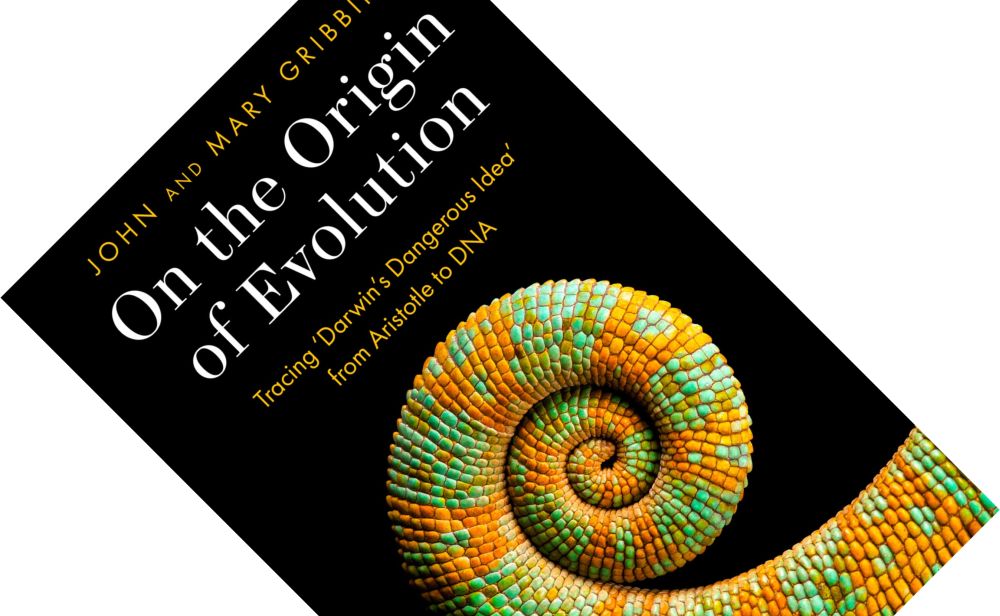
On the Origin of Evolution: Tracing ‘Darwin’s Dangerous Idea’ from Aristotle to DNA, written by John Gribbin and Mary Gribbin, published in Europe by William Collins (a HarperCollins imprint) in November 2020 (hardback, 288 pages)
When you study the history of science, it seems there is just no way around Aristotle. In the context of this book, his legacy is the idea of the great chain of being: the notion that life can be ordered from simple to complex forms, with humans at the top as creation’s crowning glory. It was readily adopted by Christian thinkers and hamstrung evolutionary thinking for millennia.
Still, as the first third of this book shows, some people did ponder both man’s place in nature and the relationships between living beings. Liberally quoting from their writings, the authors introduce you to notable characters and their brilliant early flashes of insight. For example, Thomas Aquinas, writing in the 13th century, allowed for species to develop in their striving for perfection but rejected the idea of new ones arising after God’s act of creation. Fossils were long misunderstood, neither recognized as ancient nor as the remains of extinct creatures. I was therefore particularly fascinated by 17th-century British polymath Robert Hooke who may well have been one of the first to recognize fossils for what they were. His ideas on species formation and extinction seem prescient. In the 1770s, Lord Monboddo already argued that humans descended from apes. And yet, the dots were not connected into a bigger picture. Particular sticking points were extinction and the age of the Earth, a puzzle to which James Hutton and other geologists would later contribute much.
When the book gets to Darwin, the tempo slows right down and the middle third of the book examines Darwin’s life and simultaneous developments around him. The Gribbins sketch how Darwin, ever careful, worked on his ideas for decades, also because he felt that, as a geologist, one could not “examine the question of species who has not minutely described many” (p. 134). Something he subsequently spent years on. The history of how Alfred Russel Wallace later came to similar conclusions and ran them past Darwin in a letter, and how Charles Lyell and Joseph Hooker presented both their work at a meeting of the Linnean Society, is well-known. What the Gribbins here clarify is that, if it seems strange to us now that Wallace’s letter was publicly presented by a third party without his consent, this was the custom of the time. Communications of scientific interest were expected to be made public as quickly as possible. Various quotes from Wallace indeed show nothing but a man who was very chuffed to have his work mentioned alongside Darwin’s.
“[…] the first two parts of On the Origin of Evolution read like a well-oiled machine, [numerous] details left me with the impression that the authors have been meticulous […]”
The Gribbins also pay attention to Erasmus Darwin (Charles’s grandfather) and relevant contemporaries such as Jean-Baptiste de Lamarck and Georges Cuvier. They give Lamarck his due and note the irony of him accepting evolution but denying extinction, and Cuvier denying evolution but accepting extinction. If the two had not ended up bitter enemies they might have put two and two together. Another lesser-known figure who came tantalisingly close, and virtually coined the term natural selection, was arborist Patrick Matthew who buried his thoughts in the appendix to a book on naval timber. Darwin was unaware of his work despite Matthew’s later public charges, the Gribbins write. Other notable details are a public admission to a change of heart over whether a letter from Darwin to Wallace was intended to warn Wallace off. The Gribbins used to think so, but are now persuaded it was not. They also clarify the oft-repeated factoid of On the Origin of Species selling out on the day of publication: “this is only true in the sense that all the copies had been bought up by the bookshops, ready to sell on to their customers” (p. 166). An observation that, working for a bookseller myself, rings true. These and other details left me with the impression that the authors have been meticulous up to this point. (I admit this is a risky thing to say; whole academic careers have been built on studying Wallace and Darwin’s lives, so cue people more knowledgeable than myself pointing out errors next).
On the Origin of Evolution competes for your attention with Rebecca Stott’s 2012 book Darwin’s Ghosts, which similarly traced Darwin’s intellectual forebears. That book ended with the above-mentioned presentation at the Linnean Society, so the Gribbins have the opportunity to set themselves apart with the last third of their book, which examines the development of Darwin’s ideas by later scientists. Although I enjoyed the book up to this point, the last part is where it fell a bit flat for me.
The Gribbins weave their narrative through the work of Gregor Mendel and its triple rediscovery decades later; the discovery of the structure of DNA, honouring the long course described in Unravelling the Double Helix; and the discovery of how DNA codes for amino acids. It touches on horizontal gene transfer, epigenetics, and twin studies and the discovery of polygenic traits. All important topics for sure, but they omit so many others as to make this part of their history rather haphazard.
“[…] the last third of their book, which examines the development of Darwin’s ideas by later scientists. […] omits so many [topics] as to make this part of their history rather haphazard.”
Two oversights stand out. They discuss how extinction ultimately became accepted but leave out the next chapter: the mass-extinction debates, which was a conflict between uniformitarianism and catastrophism. Similarly, they recognize Wallace as the grandfather of biogeography but leave out how the long-resisted idea of plate tectonics explained palaeobiogeographic patterns. Basically, they completely ignore the rise of palaeobiology and its contributions to evolution. Beyond these, they mention horizontal gene transfer, but not Carl Woese and his proposal of a Last Universal Common Ancestor. They feature Thomas Hunt Morgan’s research on Drosophila, but not the emergence of evolutionary developmental biology. They profile Barbara McClintock’s struggle to get her discovery of mobile genetic elements accepted but not Lynn Margulis‘s struggle to get endosymbiosis recognized. And although the Sources and Further Reading section lists other major thinkers, there is no discussion of, say, Ernst Mayr and the problem with species definitions, the work of Stephen Jay Gould, or the debate on levels of selection. Sexual selection and phylogenetics are completely absent.
They cram this last part in a mere 70 pages while repeatedly mentioning not being able to go deeper. I am not sure why. At 253 pages of text, the book is not particularly long. Had they spent another 50 or even 100 pages, I feel they could have done it more justice. I will be the first to concur that writing such an overview is challenging. Part of the problem, I think, is that the authors (John a science journalist with a PhD in astrophysics, Mary a teacher) do not have a thorough background in (molecular) biology and reach into unfamiliar territory, as evidenced by some elementary mistakes. On p. 218 they mention DNA contains three purines and one pyrimidine, and correct themselves two sentences later (there are two of each). They mix up the DNA base pairs on p. 226 (CT and AG pairs) but get it right on p. 227. And on p. 244 they mention the human genome consists of 6 billion base pairs which is double the actual number. Anyone who has had to study Alberts’s brick will have had these facts drummed into them, but their acknowledgements are silent on whether fellow biologists provided feedback on the manuscript. Now, I do not want to blow a few factual errors out of proportion, but together with the brevity of the material included, and the many other topics not covered, this last part left me less than satisfied.
Overall then, this book is an excellent introduction to the history of evolution before and up to Darwin that retains important detail despite being relatively brief. I was less impressed with the coverage on the developments since Darwin, which would benefit from supplementary reading. I hope a future review of The Black Box of Biology will fill in some of the blanks regarding molecular biology.
Disclosure: The publisher provided a review copy of this book. The opinion expressed here is my own, however.
Other recommended books mentioned in this review:
__________________________________________________________________
__________________________________________________________________
__________________________________________________________________
__________________________________________________________________
__________________________________________________________________
__________________________________________________________________
__________________________________________________________________
__________________________________________________________________
__________________________________________________________________
